BACC212 - Management Accounting: Costing and Profit Improvement
VerifiedAdded on 2023/06/14
|8
|1118
|292
Report
AI Summary
This report provides an overview of management accounting principles, focusing on costing methods and strategies for profit improvement, particularly within the context of the Australian dairy industry. It discusses the application of process costing in mass production environments, emphasizing its role in determining product costs and informing decisions related to cost control. The report also explores factors beyond production costs that can enhance a business's net profit, such as reducing the cost of goods sold, managing labor and operational expenses, and streamlining overheads through effective stock control. The content aligns with course BACC212/MPA703 and offers insights relevant to students studying management accounting. Desklib provides access to similar assignments and study tools for students.
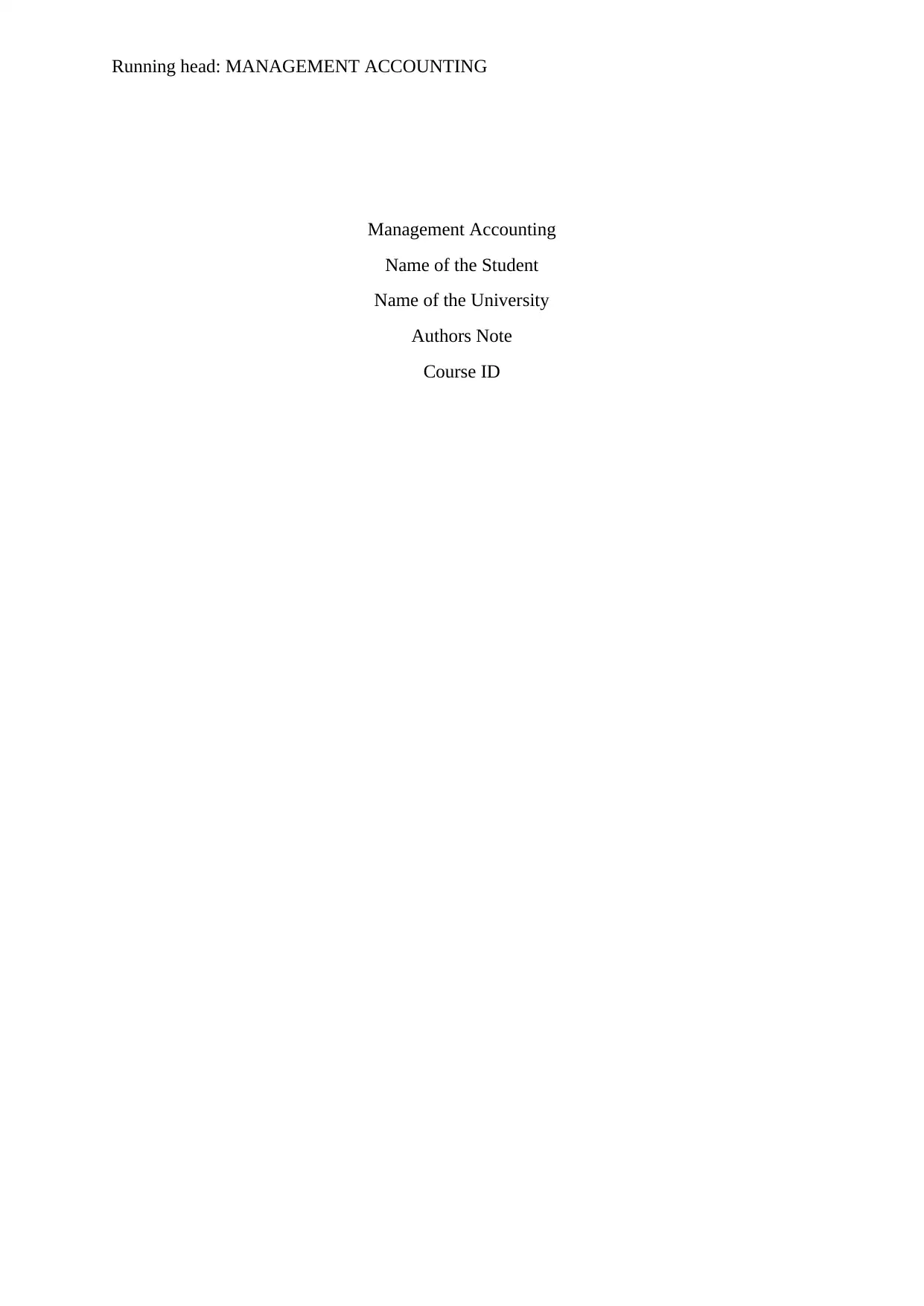
Running head: MANAGEMENT ACCOUNTING
Management Accounting
Name of the Student
Name of the University
Authors Note
Course ID
Management Accounting
Name of the Student
Name of the University
Authors Note
Course ID
Paraphrase This Document
Need a fresh take? Get an instant paraphrase of this document with our AI Paraphraser
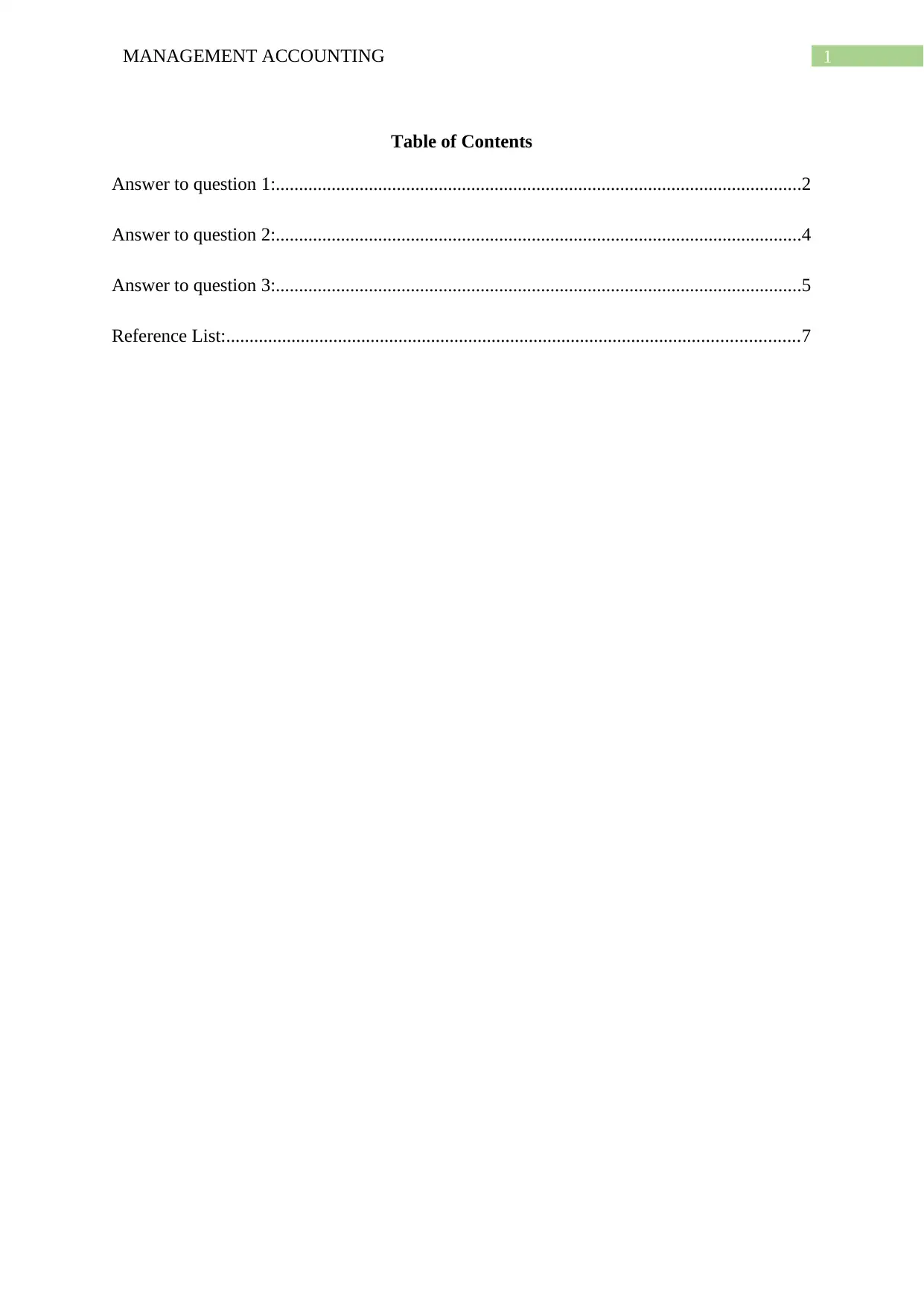
1MANAGEMENT ACCOUNTING
Table of Contents
Answer to question 1:.................................................................................................................2
Answer to question 2:.................................................................................................................4
Answer to question 3:.................................................................................................................5
Reference List:...........................................................................................................................7
Table of Contents
Answer to question 1:.................................................................................................................2
Answer to question 2:.................................................................................................................4
Answer to question 3:.................................................................................................................5
Reference List:...........................................................................................................................7
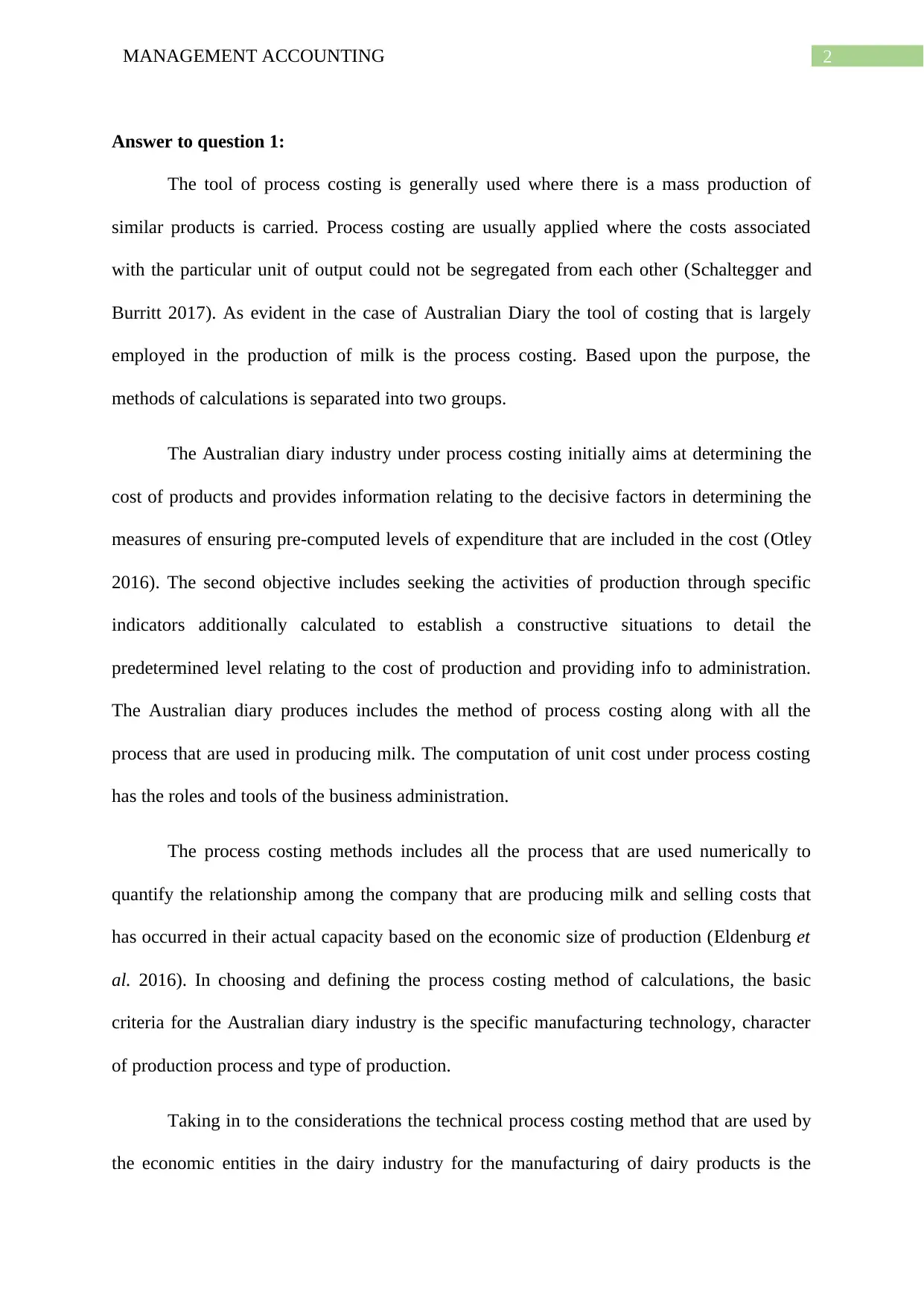
2MANAGEMENT ACCOUNTING
Answer to question 1:
The tool of process costing is generally used where there is a mass production of
similar products is carried. Process costing are usually applied where the costs associated
with the particular unit of output could not be segregated from each other (Schaltegger and
Burritt 2017). As evident in the case of Australian Diary the tool of costing that is largely
employed in the production of milk is the process costing. Based upon the purpose, the
methods of calculations is separated into two groups.
The Australian diary industry under process costing initially aims at determining the
cost of products and provides information relating to the decisive factors in determining the
measures of ensuring pre-computed levels of expenditure that are included in the cost (Otley
2016). The second objective includes seeking the activities of production through specific
indicators additionally calculated to establish a constructive situations to detail the
predetermined level relating to the cost of production and providing info to administration.
The Australian diary produces includes the method of process costing along with all the
process that are used in producing milk. The computation of unit cost under process costing
has the roles and tools of the business administration.
The process costing methods includes all the process that are used numerically to
quantify the relationship among the company that are producing milk and selling costs that
has occurred in their actual capacity based on the economic size of production (Eldenburg et
al. 2016). In choosing and defining the process costing method of calculations, the basic
criteria for the Australian diary industry is the specific manufacturing technology, character
of production process and type of production.
Taking in to the considerations the technical process costing method that are used by
the economic entities in the dairy industry for the manufacturing of dairy products is the
Answer to question 1:
The tool of process costing is generally used where there is a mass production of
similar products is carried. Process costing are usually applied where the costs associated
with the particular unit of output could not be segregated from each other (Schaltegger and
Burritt 2017). As evident in the case of Australian Diary the tool of costing that is largely
employed in the production of milk is the process costing. Based upon the purpose, the
methods of calculations is separated into two groups.
The Australian diary industry under process costing initially aims at determining the
cost of products and provides information relating to the decisive factors in determining the
measures of ensuring pre-computed levels of expenditure that are included in the cost (Otley
2016). The second objective includes seeking the activities of production through specific
indicators additionally calculated to establish a constructive situations to detail the
predetermined level relating to the cost of production and providing info to administration.
The Australian diary produces includes the method of process costing along with all the
process that are used in producing milk. The computation of unit cost under process costing
has the roles and tools of the business administration.
The process costing methods includes all the process that are used numerically to
quantify the relationship among the company that are producing milk and selling costs that
has occurred in their actual capacity based on the economic size of production (Eldenburg et
al. 2016). In choosing and defining the process costing method of calculations, the basic
criteria for the Australian diary industry is the specific manufacturing technology, character
of production process and type of production.
Taking in to the considerations the technical process costing method that are used by
the economic entities in the dairy industry for the manufacturing of dairy products is the
⊘ This is a preview!⊘
Do you want full access?
Subscribe today to unlock all pages.

Trusted by 1+ million students worldwide
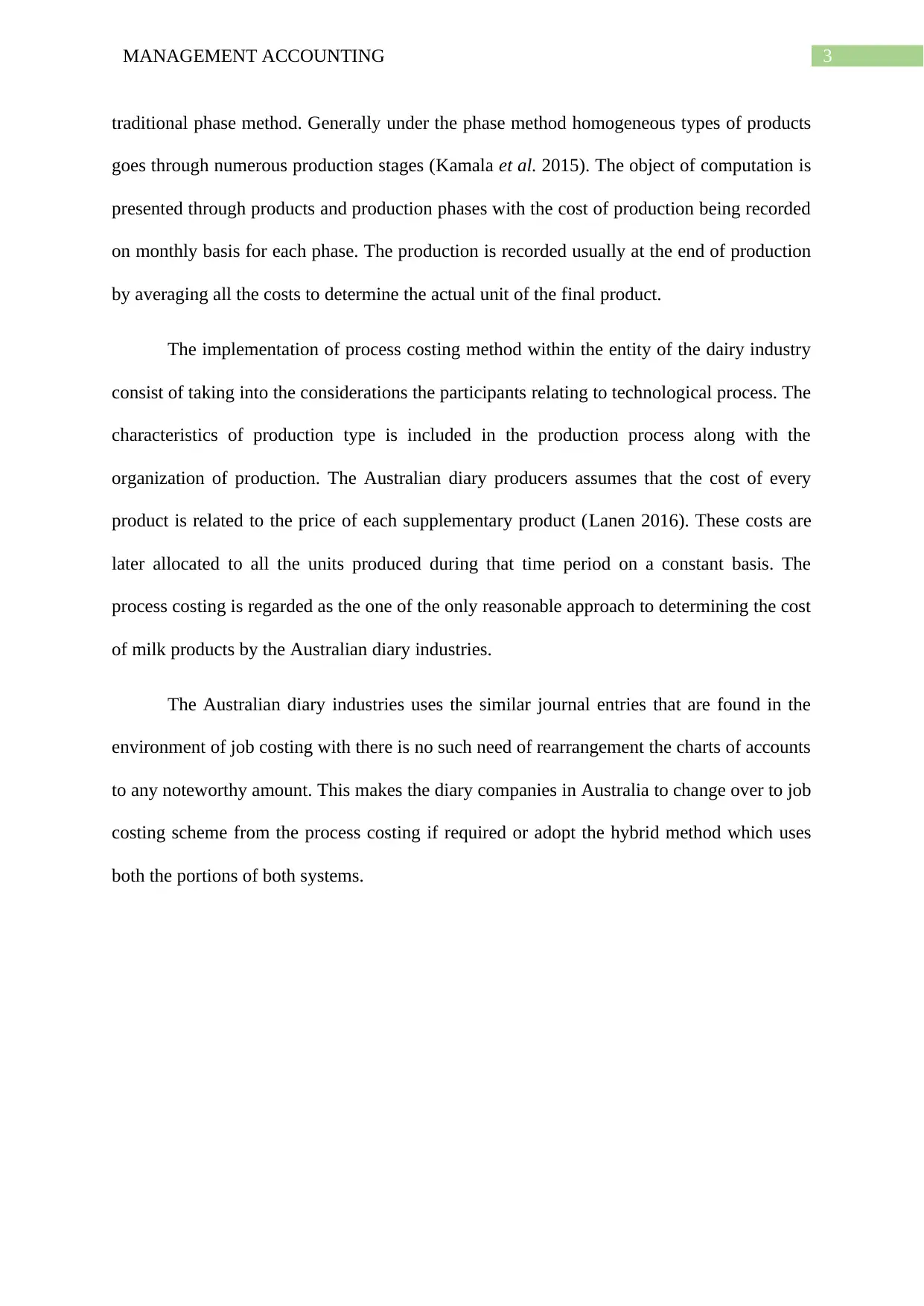
3MANAGEMENT ACCOUNTING
traditional phase method. Generally under the phase method homogeneous types of products
goes through numerous production stages (Kamala et al. 2015). The object of computation is
presented through products and production phases with the cost of production being recorded
on monthly basis for each phase. The production is recorded usually at the end of production
by averaging all the costs to determine the actual unit of the final product.
The implementation of process costing method within the entity of the dairy industry
consist of taking into the considerations the participants relating to technological process. The
characteristics of production type is included in the production process along with the
organization of production. The Australian diary producers assumes that the cost of every
product is related to the price of each supplementary product (Lanen 2016). These costs are
later allocated to all the units produced during that time period on a constant basis. The
process costing is regarded as the one of the only reasonable approach to determining the cost
of milk products by the Australian diary industries.
The Australian diary industries uses the similar journal entries that are found in the
environment of job costing with there is no such need of rearrangement the charts of accounts
to any noteworthy amount. This makes the diary companies in Australia to change over to job
costing scheme from the process costing if required or adopt the hybrid method which uses
both the portions of both systems.
traditional phase method. Generally under the phase method homogeneous types of products
goes through numerous production stages (Kamala et al. 2015). The object of computation is
presented through products and production phases with the cost of production being recorded
on monthly basis for each phase. The production is recorded usually at the end of production
by averaging all the costs to determine the actual unit of the final product.
The implementation of process costing method within the entity of the dairy industry
consist of taking into the considerations the participants relating to technological process. The
characteristics of production type is included in the production process along with the
organization of production. The Australian diary producers assumes that the cost of every
product is related to the price of each supplementary product (Lanen 2016). These costs are
later allocated to all the units produced during that time period on a constant basis. The
process costing is regarded as the one of the only reasonable approach to determining the cost
of milk products by the Australian diary industries.
The Australian diary industries uses the similar journal entries that are found in the
environment of job costing with there is no such need of rearrangement the charts of accounts
to any noteworthy amount. This makes the diary companies in Australia to change over to job
costing scheme from the process costing if required or adopt the hybrid method which uses
both the portions of both systems.
Paraphrase This Document
Need a fresh take? Get an instant paraphrase of this document with our AI Paraphraser
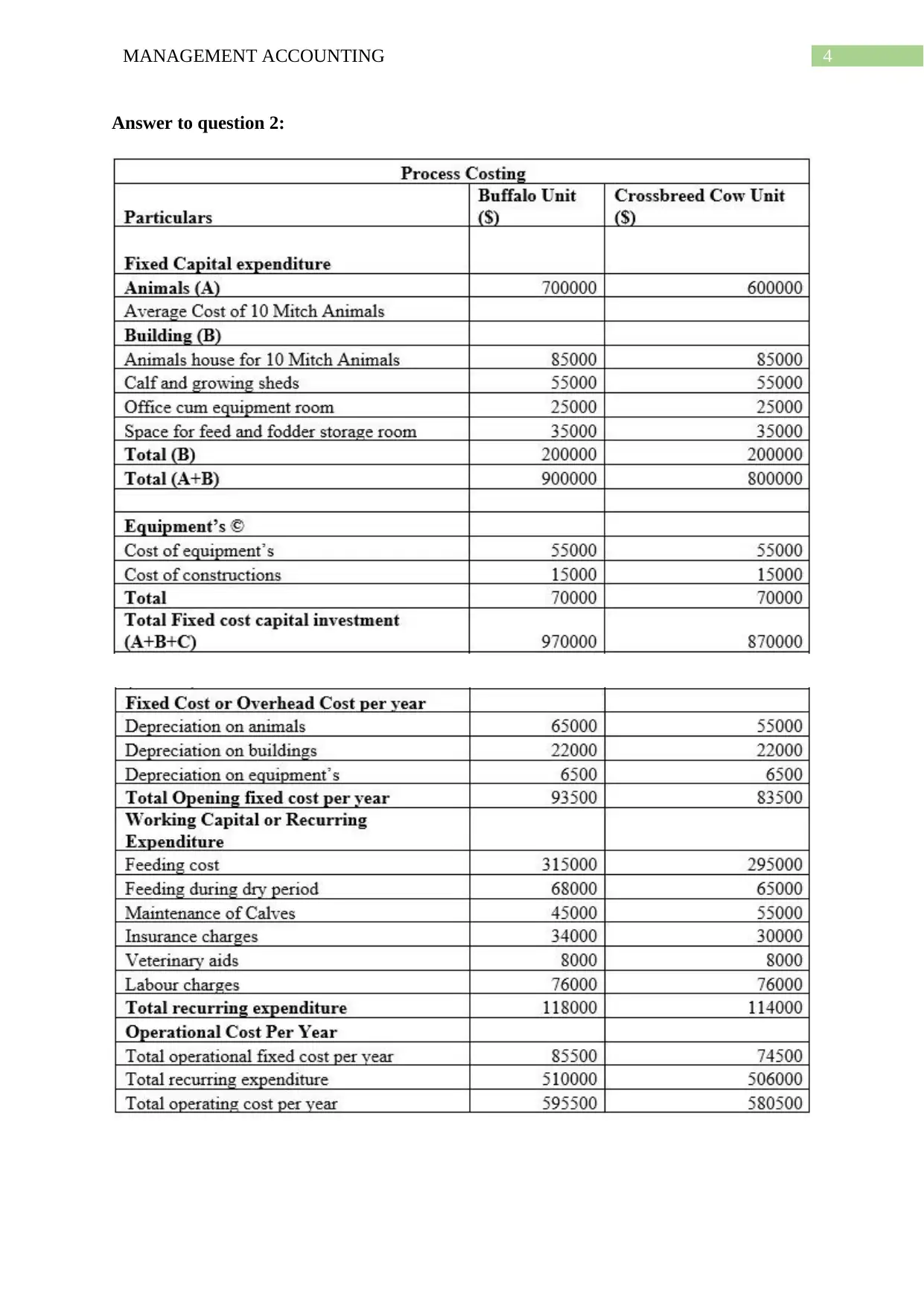
4MANAGEMENT ACCOUNTING
Answer to question 2:
Answer to question 2:
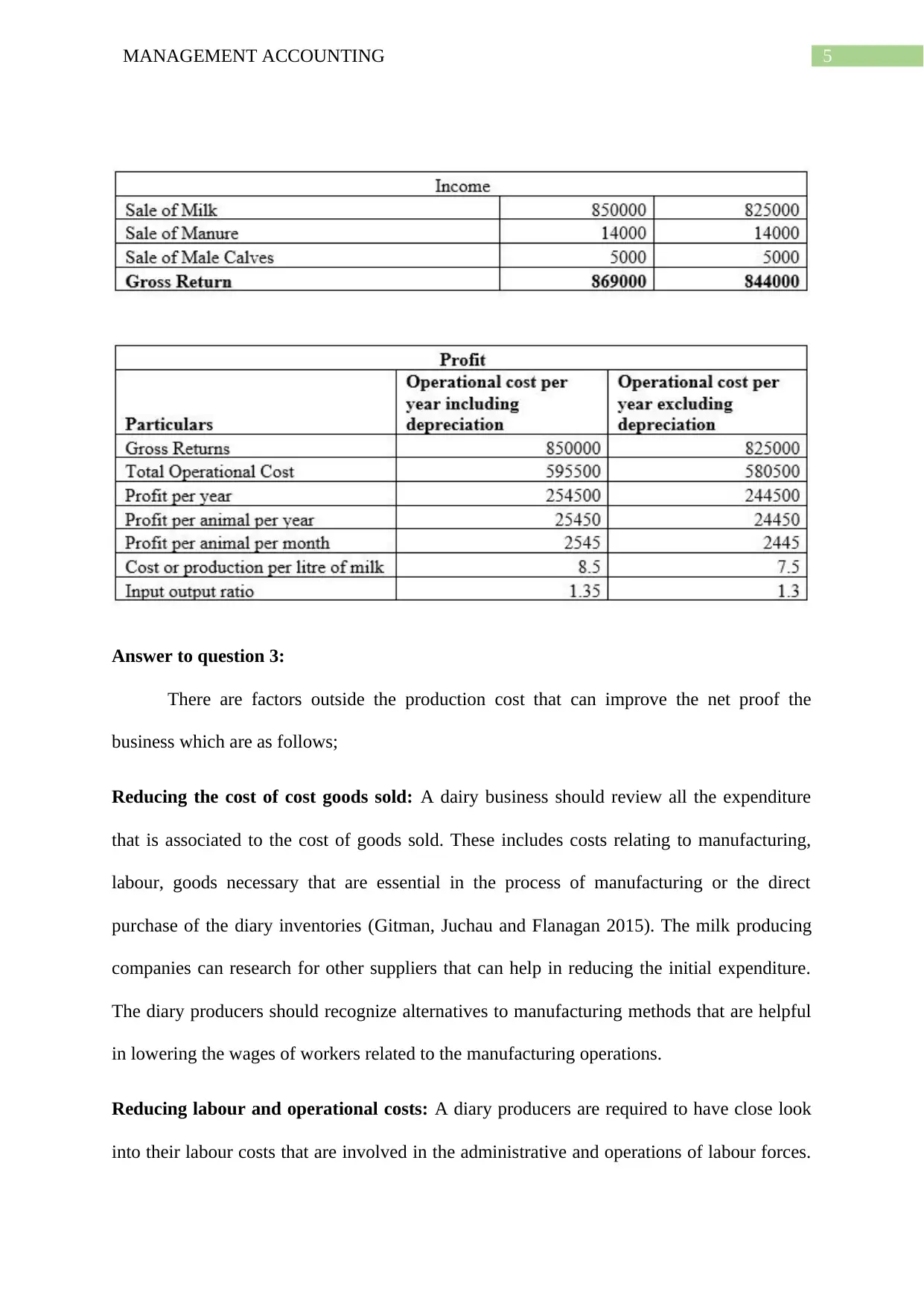
5MANAGEMENT ACCOUNTING
Answer to question 3:
There are factors outside the production cost that can improve the net proof the
business which are as follows;
Reducing the cost of cost goods sold: A dairy business should review all the expenditure
that is associated to the cost of goods sold. These includes costs relating to manufacturing,
labour, goods necessary that are essential in the process of manufacturing or the direct
purchase of the diary inventories (Gitman, Juchau and Flanagan 2015). The milk producing
companies can research for other suppliers that can help in reducing the initial expenditure.
The diary producers should recognize alternatives to manufacturing methods that are helpful
in lowering the wages of workers related to the manufacturing operations.
Reducing labour and operational costs: A diary producers are required to have close look
into their labour costs that are involved in the administrative and operations of labour forces.
Answer to question 3:
There are factors outside the production cost that can improve the net proof the
business which are as follows;
Reducing the cost of cost goods sold: A dairy business should review all the expenditure
that is associated to the cost of goods sold. These includes costs relating to manufacturing,
labour, goods necessary that are essential in the process of manufacturing or the direct
purchase of the diary inventories (Gitman, Juchau and Flanagan 2015). The milk producing
companies can research for other suppliers that can help in reducing the initial expenditure.
The diary producers should recognize alternatives to manufacturing methods that are helpful
in lowering the wages of workers related to the manufacturing operations.
Reducing labour and operational costs: A diary producers are required to have close look
into their labour costs that are involved in the administrative and operations of labour forces.
⊘ This is a preview!⊘
Do you want full access?
Subscribe today to unlock all pages.

Trusted by 1+ million students worldwide
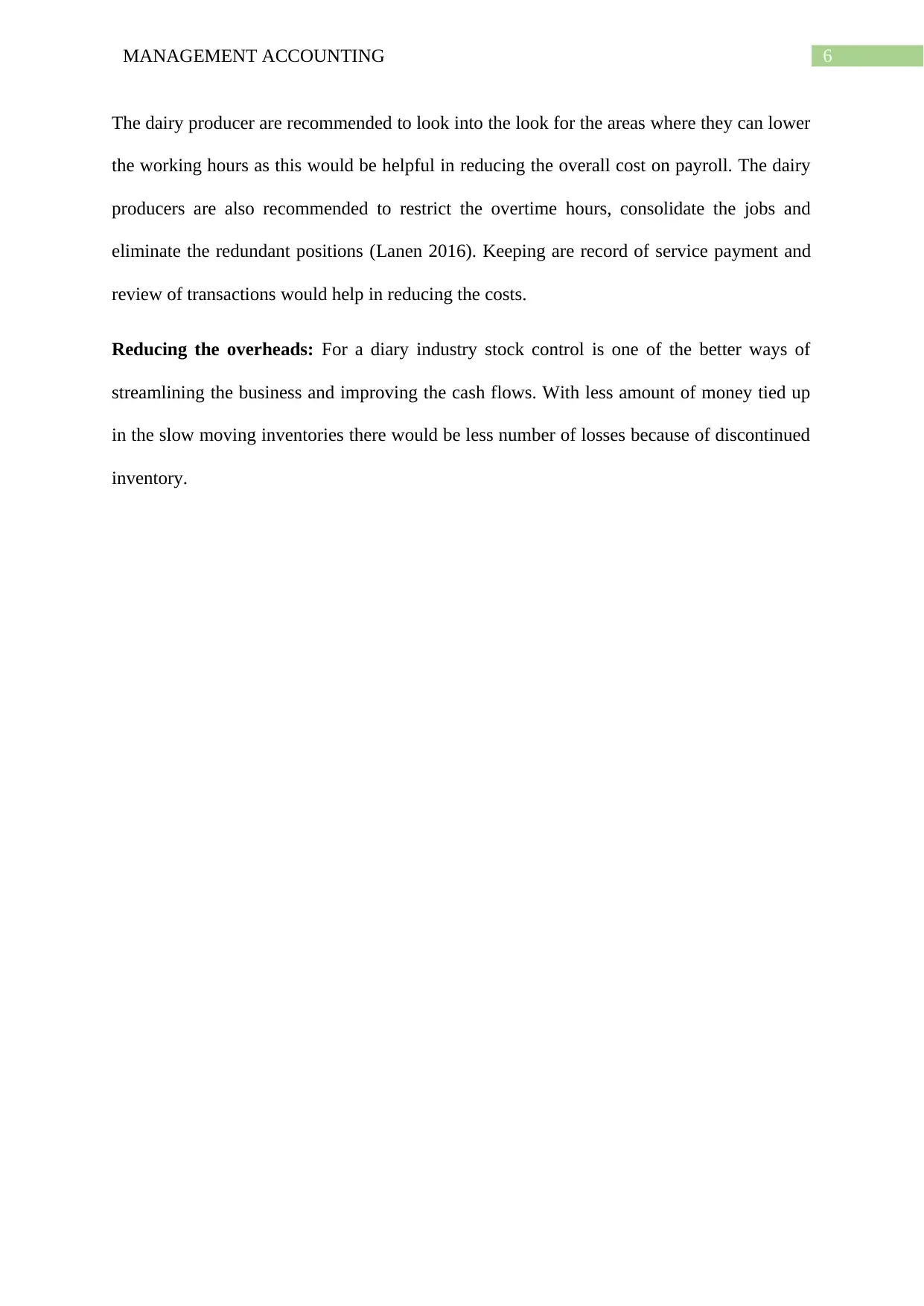
6MANAGEMENT ACCOUNTING
The dairy producer are recommended to look into the look for the areas where they can lower
the working hours as this would be helpful in reducing the overall cost on payroll. The dairy
producers are also recommended to restrict the overtime hours, consolidate the jobs and
eliminate the redundant positions (Lanen 2016). Keeping are record of service payment and
review of transactions would help in reducing the costs.
Reducing the overheads: For a diary industry stock control is one of the better ways of
streamlining the business and improving the cash flows. With less amount of money tied up
in the slow moving inventories there would be less number of losses because of discontinued
inventory.
The dairy producer are recommended to look into the look for the areas where they can lower
the working hours as this would be helpful in reducing the overall cost on payroll. The dairy
producers are also recommended to restrict the overtime hours, consolidate the jobs and
eliminate the redundant positions (Lanen 2016). Keeping are record of service payment and
review of transactions would help in reducing the costs.
Reducing the overheads: For a diary industry stock control is one of the better ways of
streamlining the business and improving the cash flows. With less amount of money tied up
in the slow moving inventories there would be less number of losses because of discontinued
inventory.
Paraphrase This Document
Need a fresh take? Get an instant paraphrase of this document with our AI Paraphraser
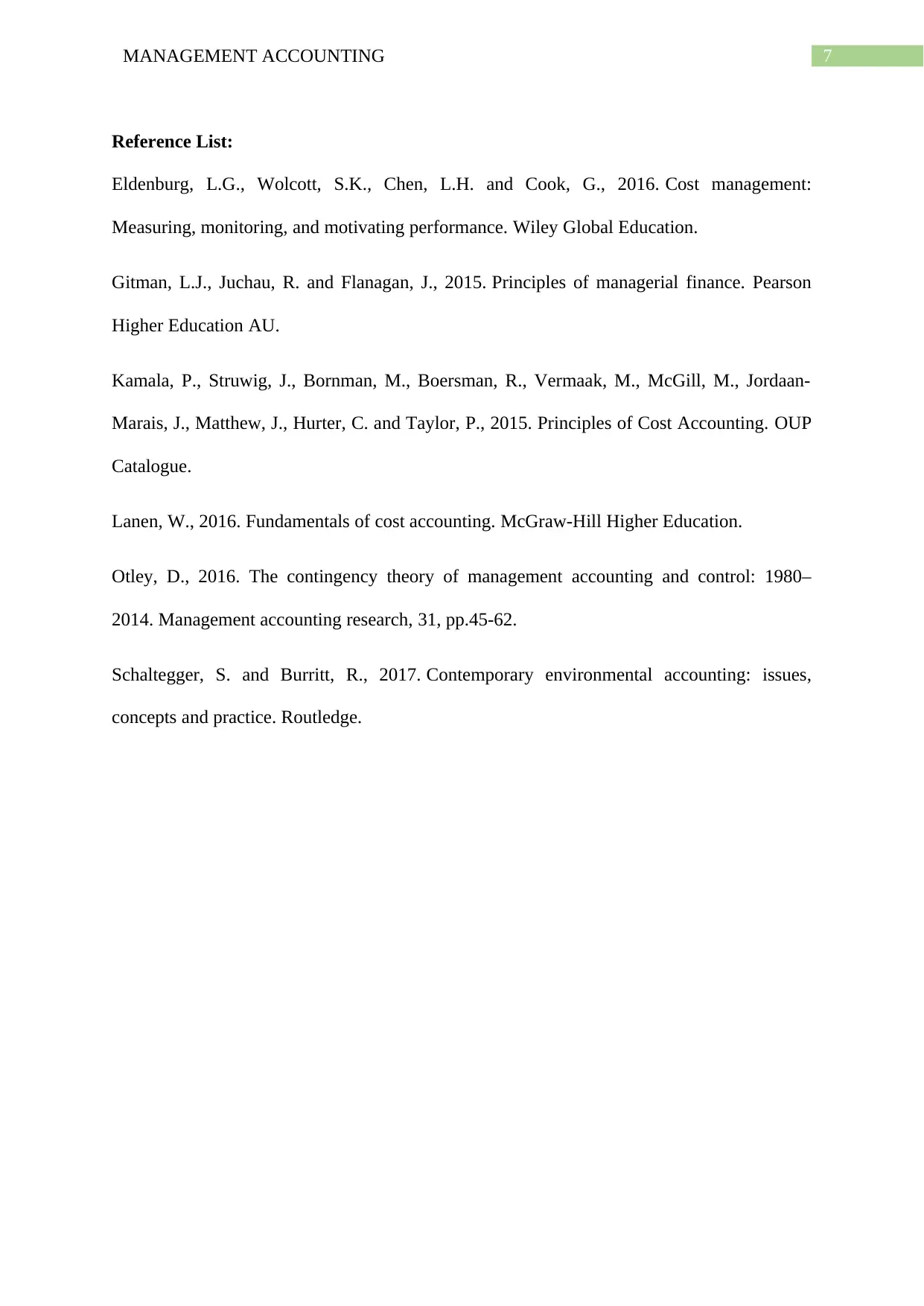
7MANAGEMENT ACCOUNTING
Reference List:
Eldenburg, L.G., Wolcott, S.K., Chen, L.H. and Cook, G., 2016. Cost management:
Measuring, monitoring, and motivating performance. Wiley Global Education.
Gitman, L.J., Juchau, R. and Flanagan, J., 2015. Principles of managerial finance. Pearson
Higher Education AU.
Kamala, P., Struwig, J., Bornman, M., Boersman, R., Vermaak, M., McGill, M., Jordaan-
Marais, J., Matthew, J., Hurter, C. and Taylor, P., 2015. Principles of Cost Accounting. OUP
Catalogue.
Lanen, W., 2016. Fundamentals of cost accounting. McGraw-Hill Higher Education.
Otley, D., 2016. The contingency theory of management accounting and control: 1980–
2014. Management accounting research, 31, pp.45-62.
Schaltegger, S. and Burritt, R., 2017. Contemporary environmental accounting: issues,
concepts and practice. Routledge.
Reference List:
Eldenburg, L.G., Wolcott, S.K., Chen, L.H. and Cook, G., 2016. Cost management:
Measuring, monitoring, and motivating performance. Wiley Global Education.
Gitman, L.J., Juchau, R. and Flanagan, J., 2015. Principles of managerial finance. Pearson
Higher Education AU.
Kamala, P., Struwig, J., Bornman, M., Boersman, R., Vermaak, M., McGill, M., Jordaan-
Marais, J., Matthew, J., Hurter, C. and Taylor, P., 2015. Principles of Cost Accounting. OUP
Catalogue.
Lanen, W., 2016. Fundamentals of cost accounting. McGraw-Hill Higher Education.
Otley, D., 2016. The contingency theory of management accounting and control: 1980–
2014. Management accounting research, 31, pp.45-62.
Schaltegger, S. and Burritt, R., 2017. Contemporary environmental accounting: issues,
concepts and practice. Routledge.
1 out of 8
Related Documents
Your All-in-One AI-Powered Toolkit for Academic Success.
+13062052269
info@desklib.com
Available 24*7 on WhatsApp / Email
![[object Object]](/_next/static/media/star-bottom.7253800d.svg)
Unlock your academic potential
Copyright © 2020–2025 A2Z Services. All Rights Reserved. Developed and managed by ZUCOL.




